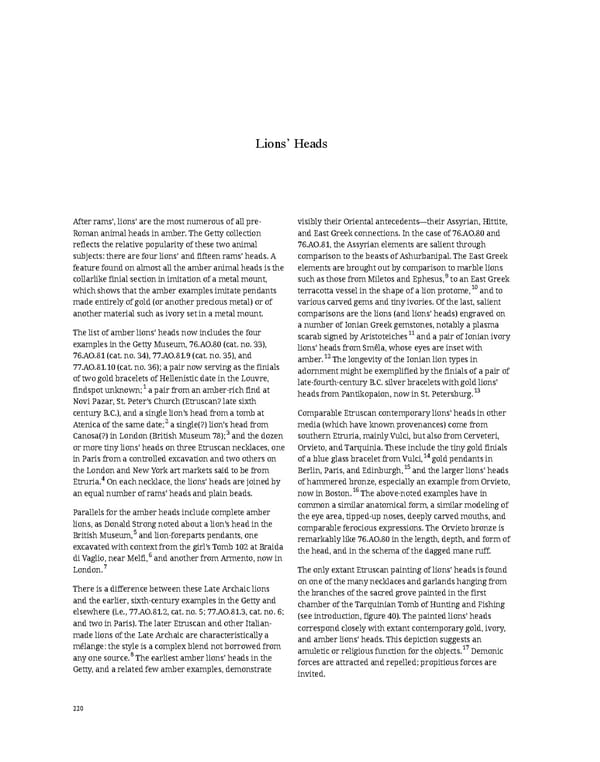Lions’ Heads After rams’, lions’ are the most numerous of all pre- visibly their Oriental antecedents—their Assyrian, Hittite, Roman animal heads in amber. The Getty collection and East Greek connections. In the case of 76.AO.80 and reflects the relative popularity of these two animal 76.AO.81, the Assyrian elements are salient through subjects: there are four lions’ and fifteen rams’ heads. A comparison to the beasts of Ashurbanipal. The East Greek feature found on almost all the amber animal heads is the elements are brought out by comparison to marble lions collarlike finial section in imitation of a metal mount, such as those from Miletos and Ephesus,9 to an East Greek which shows that the amber examples imitate pendants terracotta vessel in the shape of a lion protome,10 and to made entirely of gold (or another precious metal) or of various carved gems and tiny ivories. Of the last, salient another material such as ivory set in a metal mount. comparisons are the lions (and lions’ heads) engraved on a number of Ionian Greek gemstones, notably a plasma The list of amber lions’ heads now includes the four scarab signed by Aristoteiches11 and a pair of Ionian ivory examples in the Getty Museum, 76.AO.80 (cat. no. 33), lions’ heads from Smêla, whose eyes are inset with 76.AO.81(cat. no. 34), 77.AO.81.9 (cat. no. 35), and amber.12The longevity of the Ionian lion types in 77.AO.81.10 (cat. no. 36); a pair now serving as the finials adornment might be exemplified by the finials of a pair of of two gold bracelets of Hellenistic date in the Louvre, late-fourth-century B.C. silver bracelets with gold lions’ findspot unknown;1a pair from an amber-rich find at 13 heads from Pantikopaion, now in St. Petersburg. Novi Pazar, St. Peter’s Church (Etruscan? late sixth century B.C.), and a single lion’s head from a tomb at Comparable Etruscan contemporary lions’ heads in other Atenica of the same date;2 a single(?) lion’s head from media (which have known provenances) come from Canosa(?) in London (British Museum 78);3 and the dozen southern Etruria, mainly Vulci, but also from Cerveteri, or more tiny lions’ heads on three Etruscan necklaces, one Orvieto, and Tarquinia. These include the tiny gold finials in Paris from a controlled excavation and two others on of a blue glass bracelet from Vulci,14 gold pendants in the London and New York art markets said to be from Berlin, Paris, and Edinburgh,15 and the larger lions’ heads Etruria.4 On each necklace, the lions’ heads are joined by of hammered bronze, especially an example from Orvieto, an equal number of rams’ heads and plain beads. now in Boston.16 The above-noted examples have in common a similar anatomical form, a similar modeling of Parallels for the amber heads include complete amber the eye area, tipped-up noses, deeply carved mouths, and lions, as Donald Strong noted about a lion’s head in the comparable ferocious expressions. The Orvieto bronze is British Museum,5and lion-foreparts pendants, one remarkably like 76.AO.80 in the length, depth, and form of excavated with context from the girl’s Tomb 102 at Braida the head, and in the schema of the dagged mane ruff. di Vaglio, near Melfi,6 and another from Armento, now in London.7 The only extant Etruscan painting of lions’ heads is found on one of the many necklaces and garlands hanging from There is a difference between these Late Archaic lions the branches of the sacred grove painted in the first and the earlier, sixth-century examples in the Getty and chamber of the Tarquinian Tomb of Hunting and Fishing elsewhere (i.e., 77.AO.81.2, cat. no. 5; 77.AO.81.3, cat. no. 6; (see introduction, figure 40). The painted lions’ heads and two in Paris). The later Etruscan and other Italian- correspond closely with extant contemporary gold, ivory, made lions of the Late Archaic are characteristically a and amber lions’ heads. This depiction suggests an mélange: the style is a complex blend not borrowed from amuletic or religious function for the objects.17 Demonic any one source.8 The earliest amber lions’ heads in the Getty, and a related few amber examples, demonstrate forces are attracted and repelled; propitious forces are invited. 220
 Ancient Carved Ambers in the J. Paul Getty Museum Page 229 Page 231
Ancient Carved Ambers in the J. Paul Getty Museum Page 229 Page 231